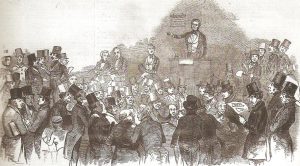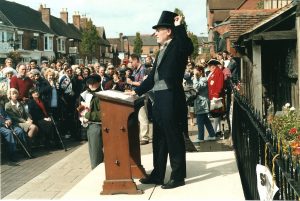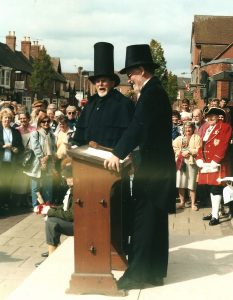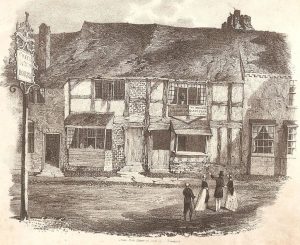16 September 1847 is a date that all those interested in Shakespeare should know. On that date an auction was held at the Auction Mart in London at which Shakespeare’s birthplace, described on the sale poster as “The Truly Heart-stirring Relic of a Most Glorious Period, and of England’s Immortal Bard”, was sold.
170 years on it’s being celebrated by the Shakespeare Birthplace Trust with a new temporary exhibition at Shakespeare’s Birthplace, running from 16 September to 29 December 2017. The exhibition will show how important figures of the day including academics John Payne Collier and Charles Knight, actor W C Macready and novelist Charles Dickens campaigned to save Shakespeare’s Birthplace.
On the day itself there is also to be a theatrical re-enactment, to be held in Henley Street outside the Birthplace at 12 and 2pm. This isn’t the first time: on 16 September 1997, the 150th anniversary of the sale, the auction was staged. The town’s beadle made the announcements, actor Paul Greenwood took charge as the auctioneer Edmund Robins, and senior employees of the Shakespeare Birthplace Trust joined in enthusiastically: Nic Walsh (in charge of running the houses) and the Director, Roger Pringle, both took the roles of people bidding at the auction. Mr Pringle, wearing a magnificent hat, submitted the winning bid of £3000. For the re-enactment American circus proprietor PT Barnum made a dramatic intervention. In fact although there were rumours he would attempt to buy the house, he did not attend the auction. The actual auction included some drama as one person demanded an assurance that Shakespeare had really been born in the house, something that sadly nobody has ever been able to prove, though there is every reason to believe that he had.
In some ways the auction was the easy bit. If they think about it at all, most people assume that the Shakespeare Birthplace Trust, the charitable organisation that now cares for all five Shakespeare houses, was founded immediately after the purchase in 1847. In fact the SBT was not incorporated by Act of Parliament until 1891, 44 years after the sale.
Before the sale took place, assurances had been given that the government would take on the administration of the house once it had been purchased, and two committees were set up specifically to fundraise. The London Committee gained the support of many celebrities, right up to Prince Albert, but the Stratford Birthplace Committee was formed by renaming a body that already existed, the Shakespearean Monumental Committee. This in turn had been formed by Stratford-upon-Avon’s Shakespeare Club that in 1835 successfully restored Shakespeare’s tomb and the chancel in Holy Trinity Church and had indicated its willingness to preserve Shakespeare’s house and other properties such as the site of New Place.
After the excitement of the auction around £500 was still needed to pay for the house. The Government declined to take on any responsibility and the London Committee soon lost interest in fundraising. It fell to the Stratford Birthplace Committee to arrange a loan with a local bank that took until 1855 to pay off. They also arranged for the house to be opened to the public and on the strength of a promised inheritance organised the desperately-needed restoration of the house. When this money too failed to materialised they were forced to take out another loan. Finally, this group of mostly local people were able in 1866 to hand over the responsibility for the house to the Corporation of Stratford-upon-Avon, to be managed by a body of Trustees. It was this organisation, with its powers redefined and clarified, that turned into the SBT. The contribution made by local people to the purchase and development of the Birthplace is often overlooked, but should also be celebrated. The story of local involvement in the Birthplace is told in The Story of the Shakespeare Club of Stratford-upon-Avon and in Dr Levi Fox’s book The Shakespeare Birthplace Trust: a Personal Memoir.
The acquisition of the Birthplace was a hugely significant event. In her book Shakespeare’s Shrine, Julia Thomas concludes “It was the auction of the property and its purchase for the nation that changed the course of the building’s history and, with it, the fortunes of Stratford-upon-Avon. It also changed the fortunes of Shakespeare”. (p 156).Literary tourism, that links the writings of an author with their origins, began with the Birthplace. She also notes that it helped make the connection between Shakespeare’s plays and the home. Not just theatrical texts, they were to be enjoyed more like novels, every home having a copy of the Complete Works that would be read out loud as the Bible was. At least 162 editions of the plays were published between 1851 and 1860, catering to many different markets.
With the house becoming a major tourist attraction, it became necessary to try to answer questions about the connections between the man, his works, a challenge that continues to this day.





